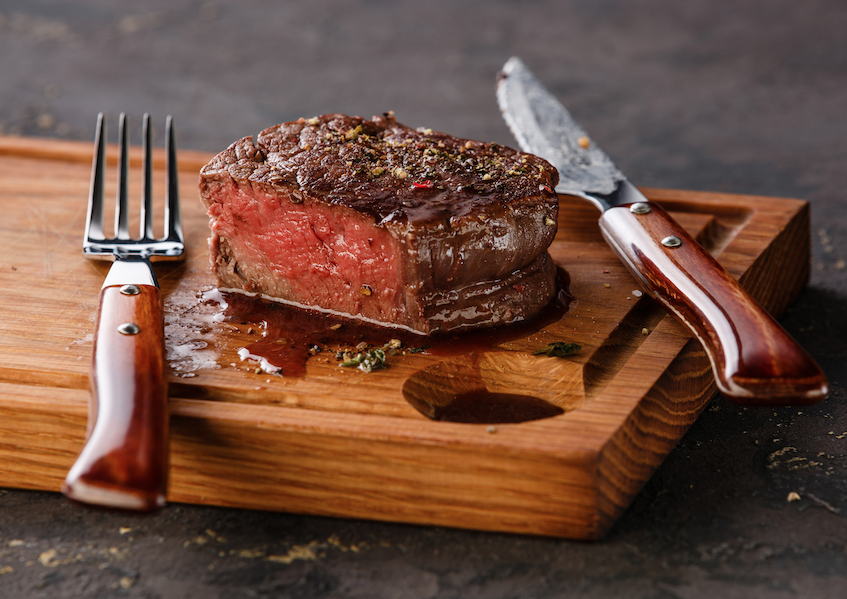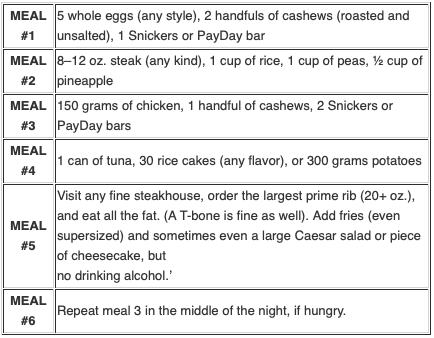Fat Loading For Maximum Cuts and Fullness

If you’ve used fat loading to peak for a contest or a photo shoot in the last 10 years, chances are your approach was a variation on the “Fat Load” I created way back in the late ‘80s.
However, the recent trend of internet “gurus” has now mutated some of my concepts into flawed protocols. But as they stray away from these methods, they violate the principles behind them. In the end, they can hurt the chances of having a polished and peaked physique. Fat Loading is the most effective way to peak a physique and volumize muscles in those crucial hours before stepping onstage. Let’s take a closer look at how and why it works.
Understanding Energy Storage
Energy is stored throughout the body in various places for various uses. For competitors, the number one emphasis is maximum fuel storage inside the muscles, but as little as possible in the interstitial spaces between the cells. But this is nearly impossible to achieve. As a bodybuilding competitor diets to rid his body of fat, his body also sacrifices fuel storage within the muscles as well. This is the body’s way of maintaining some kind of energy balance and sustainability. The overwhelming majority of competitors are taught to focus on glycogen storage and replacement. But this is the blind side of a peaking strategy. Any biochemist can tell you that glycogen storage capacity in the body is limited. Moreover, replacement can take days or even weeks. This presents a dilemma when trying to peak a physique that has been depleted by weeks of calorie deficits and intense training.
The Trouble With Carb Loading
 Beginners to pre-contest dieting often use the misplaced approach of volumizing muscles before a show by carb loading. The usual recognized recipe for carb loading is 6–10 grams of carbs per kilo of body weight over three days. Sounds easy and looks good on paper! But it’s flirting with disaster when trying to cosmetically peak a physique. For the 220 -pound bodybuilder, for example, this amount is upwards of 1,000 grams of carbs over three days. However, this “recipe” isn’t the whole story, and it’s where most competitors sabotage months of hard dieting by following a process without understanding all the contributing factors. The storage capacity for glycogen is much lower than these amounts above. The storage limit is said to be about 400 grams. And what most “experts” don’t understand is that the body super-compensates to energy sites where the energy is most needed. So for glycogen loading, most of these calories go to and are stored in the liver. Moreover, true glycogen loading takes time, and the time involved will certainly compromise the cosmetically prepared, peaked physique. And trust me, these are just a few of the many issues with carb loading.
Beginners to pre-contest dieting often use the misplaced approach of volumizing muscles before a show by carb loading. The usual recognized recipe for carb loading is 6–10 grams of carbs per kilo of body weight over three days. Sounds easy and looks good on paper! But it’s flirting with disaster when trying to cosmetically peak a physique. For the 220 -pound bodybuilder, for example, this amount is upwards of 1,000 grams of carbs over three days. However, this “recipe” isn’t the whole story, and it’s where most competitors sabotage months of hard dieting by following a process without understanding all the contributing factors. The storage capacity for glycogen is much lower than these amounts above. The storage limit is said to be about 400 grams. And what most “experts” don’t understand is that the body super-compensates to energy sites where the energy is most needed. So for glycogen loading, most of these calories go to and are stored in the liver. Moreover, true glycogen loading takes time, and the time involved will certainly compromise the cosmetically prepared, peaked physique. And trust me, these are just a few of the many issues with carb loading.
Osmotic Influence
One gram of carbohydrate stored in your muscles as glycogen draws with it exactly 2.7 grams of water in the process. From the above, we know that the body has a limited capacity for storage within the muscles. And within this capacity, it must store 2.7 grams of water with each gram of glycogen. Well, 400 grams is only 1,600 calories. But the traditional recipe above for the 220-pound bodybuilder called for 1,000 grams over a few days. So clearly, we have an issue when intake exceeds storage capacity. And this plays itself out in the guts of the ill-advised carb-loading strategy.
Poor Digestion
 Glycogen loading in this short window of time is hard on digestion. If you’ve dieted down for even a local show, you’ll know what I’m talking about here. Almost every competitor can tell a horror story about that reality! Sudden and dense infusion of sugars into the gut produces a very specific osmotic response. Sugars attract water to the gut to aid digestion. So, the already-dehydrated competitor is signalling the body to pull water from the muscles and deliver it to the gut to aid in digesting all these sudden carbohydrate calories. This creates bloating and cramps, and the cramps are now in both the gut and the muscles, since water has been displaced to aid digestion. Clearly, we have a worst-case scenario happening, rather than a best-case scenario. And on top of this, the attempt to load beyond the body’s limited storage capacity will certainly lead to the dreaded spillover that every would-be champion has faced at one time or another. In my experience, carb loading has as much to do with ruining a stage-ready physique as it does with peaking one!
Glycogen loading in this short window of time is hard on digestion. If you’ve dieted down for even a local show, you’ll know what I’m talking about here. Almost every competitor can tell a horror story about that reality! Sudden and dense infusion of sugars into the gut produces a very specific osmotic response. Sugars attract water to the gut to aid digestion. So, the already-dehydrated competitor is signalling the body to pull water from the muscles and deliver it to the gut to aid in digesting all these sudden carbohydrate calories. This creates bloating and cramps, and the cramps are now in both the gut and the muscles, since water has been displaced to aid digestion. Clearly, we have a worst-case scenario happening, rather than a best-case scenario. And on top of this, the attempt to load beyond the body’s limited storage capacity will certainly lead to the dreaded spillover that every would-be champion has faced at one time or another. In my experience, carb loading has as much to do with ruining a stage-ready physique as it does with peaking one!
Fat-Loading Solution
If we turn our attention to how the body really stores energy, we see the importance of intramuscular fats and triglycerides and how easy it can be to manipulate these for contest peaking. Keep in mind that the 220-pound bodybuilder mentioned above has a virtually unlimited storage capacity of fats within the muscle (approximately 10,000 calories). The key is in understanding proper super-compensation. Remember, once body fat has been reduced to contest or photoshoot levels, the body is in a depleted state. It will super-compensate energy stores to where the energy is needed most. And for a depleted body, energy is always stored first within the muscle, if it’s a saturated fat source. (Remember: Glycogen supercompensation goes primarily to the liver.)
Fats Don’t Store Water With Them
 Unlike carbs, dietary fats don’t tend to store water along with them. Fats don’t tend to create, release, or displace metabolic water throughout your body. They tend to create more of a magnetic effect and draw and absorb water into the cell along with them. This has the effect of volumizing muscle while simultaneously pulling water from the undesired interstitial spaces and the gut into the muscles. This is what peaking is supposed to do. But this isn’t the whole story.
Unlike carbs, dietary fats don’t tend to store water along with them. Fats don’t tend to create, release, or displace metabolic water throughout your body. They tend to create more of a magnetic effect and draw and absorb water into the cell along with them. This has the effect of volumizing muscle while simultaneously pulling water from the undesired interstitial spaces and the gut into the muscles. This is what peaking is supposed to do. But this isn’t the whole story.
The Need For Carbs And Fats
Fats alone won’t volumize and peak the depleted physique. Taking in carbs along with fats, in well-timed intervals, will deliver as much glycogen swelling into the muscles as possible. But there’s no risk of spill-over, because the delivery system is different, since fats are accentuated, not just carbs.
How To Do It?
 Well, the methods can vary, and the application should always be an individual one. This is why I always say, “it’s not the recipe – it’s the chef.” How much super-compensation someone can handle depends on what he’s been through in terms of diet and training and how depleted his cells are. There are no one-size-fits-all last-week peaking recipes, or I’d simply put them in a book and make millions! Having said that, the general strategy is as follows:
Well, the methods can vary, and the application should always be an individual one. This is why I always say, “it’s not the recipe – it’s the chef.” How much super-compensation someone can handle depends on what he’s been through in terms of diet and training and how depleted his cells are. There are no one-size-fits-all last-week peaking recipes, or I’d simply put them in a book and make millions! Having said that, the general strategy is as follows:
2 Days Out From A Show
| The first day is a “primer” for fat loading: Double your calorie intake, but cut your protein in half. Make up the difference in carbs spread over several meals. This serves as a primer for the metabolic environment for the ongoing fat loading. The first day’s added carbs will be very quickly absorbed if you’ve been training hard and dieting right. The body hasn’t had time to react yet. By the second day, the door should be wide open for fat and carb loading. A typical day looks like the one below, highlighted by what I call the “Abel Body Steakhouse Fat Load.” |
Day Before The Contest

Contest Day
| The morning of the show usually continues the fat loading. Depending on how dry the competitor looks at this point, I use one of two options: The first is to eat three or four whole eggs along with four or five large rice cakes covered with peanut butter and add jelly. The second option is to eat steak or eggs, with a large bowl of oatmeal (to replace some water) with brown sugar added. |
The rest of the day focuses on normal contest dieting or more fat loading/simple carbs, according to the athlete’s biofeedback. But one word of caution is in order. Once a person starts loading and starts using fats as well, intestinal motility and digestion slows down. Therefore, the timing of meals becomes very important. The stomach can handle only so much incoming food when it hasn’t been used to it for so many weeks of strict dieting. Again, this is why expertise is so highly valued.
The Final Word
When you don’t want to play dice in the last few days before a show with hardcore, risky procedures such as insulin loading with carb infusion, fat loading is the triedand- true method of peaking the physique for a contest. It’s enjoyable, it’s productive, and it works.

